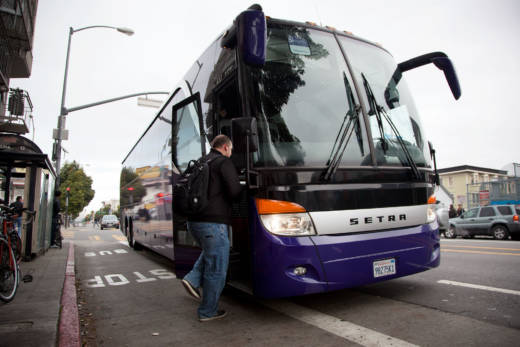In November 2015, the SFMTA board approved legislation creating the current Commuter Shuttle Program for a one-year term starting in April 2016. Opponents continued to protest, leading the Board of Supervisors to hammer out a deal with them and the tech companies in February.
Shuttle companies must apply for a permit to participate in the program, which grants them access to 80 shared Muni stops as well as 29 shuttle-only stops in the city. That's down from an original 125 approved stops before the February deal.
Rose said there are currently 17 permitted shuttle companies operating 789 shuttles on San Francisco streets. Those shuttles carry an average of just under 10,000 riders a day, a 15 percent increase from the pilot program.
As part of the program, companies must pay $7.31 each time one of their vehicles makes a stop and must agree to avoid smaller restricted streets. They must also agree to provide the SFMTA with continuous real-time GPS data so the agency can track where the shuttles are driving.
"[The GPS tracking system] makes enforcement more efficient by allowing us to know when shuttles use restricted streets and allows us to issue penalties when we need to," Rose said.
Rose points to effective enforcement -- fueled by the GPS system and a dedicated enforcement team -- as one of the key reasons the program has been so successful. Shuttle companies are fined $250 if one of their vehicles drives on an unauthorized street. These fines have totaled more than $500,000 since the start of the pilot program, but the average daily number of vehicles on these no-go streets dropped from 195 in April to only 15 in August.
There's also been a 129 percent increase in monthly citations issued to shuttle vehicles between the pilot and the current program, with more than 800 citations being doled out between April and August of this year. The citations are heavily concentrated around busy locations like Valencia and 26th Streets, Divisadero and Haight Streets, and Townsend and Fourth Streets.
The SFMTA received 267 complaints about shuttles between April and August, with 99 coming in the first month. Almost a third of complaints were for shuttles operating on restricted streets. Other complaints focused on shuttles making unauthorized stops, idling, blocking traffic as well as unpermitted shuttles. The report notes that more than 40 percent of all complaints were submitted by one Noe Valley resident.
As another part of the February deal, the Board Supervisors asked the SFMTA to look into potentially creating a "hub" model for the shuttle program that would reduce and concentrate the number of shuttle spots in the city.
With the help of the San Francisco County Transportation Authority, the SFMTA studied three potential hub models: a single San Francisco hub, a BART-oriented system with five "nodes" within a quarter-mile of the eight San Francisco BART stations, and a freeway-based system with nine nodes located within a quarter-mile of freeway on- and off-ramps. It also studied a more consolidated network similar to the current program with significantly fewer pickup and dropoff locations.
In another report released last week, the two agencies determined that shuttle ridership would decrease between 24 and 45 percent under a hub model, leading to thousands of additional cars on the road each day and increased potential for crashes.
Rose said the biggest unknown with a potential switch to a hub model would be how shuttle operators would respond and if they would continue to participate in what is still a voluntary program.
"We don't have the authority to determine whether or not shuttles like these can use our city streets," Rose said. "We have the authority to create a program like we have to organize the system."
Three shuttle companies were interviewed as part of the hub study, and all three voiced concerns about reducing the number of stops and the potential for a hub system to limit commuters' access to the system. Rose said SFMTA staff would expect some companies to move their service partially or completely off the program if it were switched to a hub model.
